Ryobi D47C User Manual [en, es, fr]
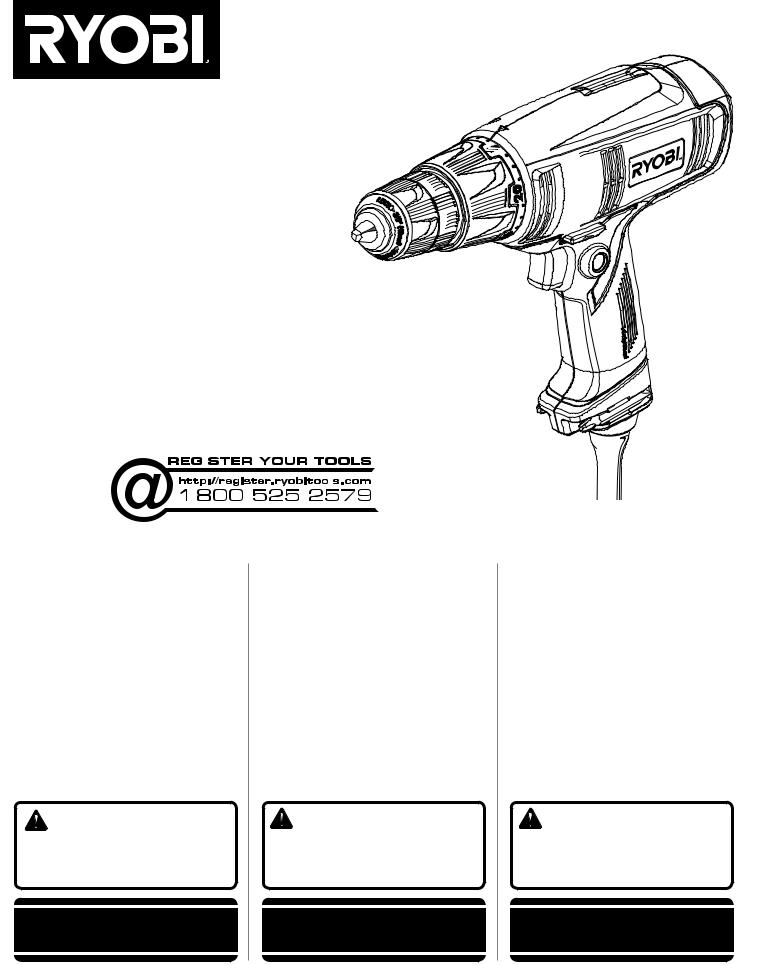
OPERATOR’S MANUAL
MANUEL D’UTILISATION MANUAL DEL OPERADOR
3/8 in. DRILL AND CLUTCHDRIVER™
PERCEUSE ET CLUTCHDRIVER™ 10 mm (3/8 po)
TALADRO Y CLUTCHDRIVER™ DE 10 mm (3/8 pulg.)
D47C / D47CG
|
|
|
|
|
|
|
|
|
|
|
|
|
|
|
|
|
|
|
|
|
|
|
|
|
|
|
|
|
|
|
|
|
|
|
|
|
|
|
|
|
|
|
|
|
|
|
|
|
|
|
|
|
|
|
|
|
|
|
|
|
|
|
|
|
|
|
|
|
|
|
|
|
|
|
|
|
|
|
|
TABLE OF CONTENTS |
|
TABLE DES MATIÈRES |
|
|
ÍNDICE DE CONTENIDO |
|
|||||||||
**************** |
|
|
|
|
**************** |
|
|
|
**************** |
|
|||||
General Power Tool |
|
|
|
|
|
Règles de sécurité relatives |
|
Advertencias de seguridad |
|
||||||
Safety Warnings............................... |
2-3 |
|
aux outils électriques....................... |
|
2-3 |
|
para herramientas eléctricas.......... |
2-3 |
|||||||
Drill Safety Warnings........................... |
3 |
|
Avertissements de sécurité |
|
Advertencias de seguridad taladro.... |
3 |
|||||||||
Symbols |
4 |
|
relatifs au perceuse............................. |
|
3 |
Símbolos |
|
4 |
|||||||
|
Symboles |
|
4 |
|
|||||||||||
Electrical |
5 |
|
|
|
Aspectos eléctricos |
|
5 |
||||||||
|
Caractéristiques électriques |
5 |
|
||||||||||||
Assembly |
6 |
|
Armado |
|
6 |
||||||||||
|
Assemblage |
|
6 |
|
|||||||||||
Operation |
6-8 |
|
|
Funcionamiento |
|
6-8 |
|||||||||
|
Utilisation |
|
6-8 |
|
|||||||||||
Maintenance |
9 |
|
|
Mantenimiento |
|
9 |
|||||||||
|
Entretien |
|
9 |
|
|||||||||||
Figures (Illustrations) |
10-11 |
|
|
Figuras (illustraciones) |
10-11 |
||||||||||
|
Figures (illustrations) |
|
10-11 |
||||||||||||
Parts Ordering and |
|
|
|
|
|
|
Pedidos de piezas |
|
|
||||||
|
|
|
|
|
|
|
|
|
|
|
|
|
|||
Service................................. |
Back page |
|
Commande de pièces |
|
|
|
y servicio....................... |
Pág. posterior |
|||||||
|
|
|
|
|
|
et dépannage..................... |
Page arrière |
|
|
|
|
||||
WARNING: To reduce the |
AVERTISSEMENT : Pour |
ADVERTENCIA: Para |
risk of injury, the user must read and |
réduire les risques de blessures, |
reducir el riesgo de lesiones, el usuario |
understandtheoperator’smanualbefore |
l’utilisateur doit lire et veiller à bien |
debe leer y comprender el manual del |
using this product. |
comprendrelemanueld’utilisationavant |
operador antes de usar este producto. |
|
d’employer ce produit. |
|
SAVE THIS MANUAL FOR |
CONSERVER CE MANUEL |
GUARDE ESTE MANUAL |
FUTURE REFERENCE |
POUR FUTURE RÉFÉRENCE |
PARA FUTURAS CONSULTAS |

GENERAL POWER TOOL SAFETY WARNINGS
|
Prevent unintentional starting. Ensure the switch is in |
|
WARNING |
the off-position before connecting to power source |
|
Read all safety warnings and all instructions. Failure to |
and/or battery pack, picking up or carrying the tool. |
|
Carrying power tools with your finger on the switch or |
||
follow the warnings and instructions may result in electric |
||
energising power tools that have the switch on invites |
||
shock, fire and/or serious injury. |
||
accidents. |
||
|
||
Save all warnings and instructions for future reference. |
Remove any adjusting key or wrench before turning |
|
The term “power tool” in the warnings refers to your mains- |
the power tool on. A wrench or a key left attached to a |
|
operated (corded) power tool or battery-operated (cordless) |
rotating part of the power tool may result in personal injury. |
|
power tool. |
Do not overreach. Keep proper footing and balance at |
|
WORK AREA SAFETY |
all times. This enables better control of the power tool in |
|
unexpected situations. |
||
Keep work area clean and well lit. Cluttered or dark |
Dress properly. Do not wear loose clothing or jewellery. |
|
areas invite accidents. |
Keep your hair, clothing and gloves away from moving |
|
Do not operate power tools in explosive atmospheres, |
parts. Loose clothes, jewellery or long hair can be caught |
|
such as in the presence of flammable liquids, gases |
in moving parts. |
|
or dust. Power tools create sparks which may ignite the |
If devices are provided for the connection of dust |
|
dust or fumes. |
extraction and collection facilities, ensure these are |
|
Keep children and bystanders away while operating a |
connected and properly used. Use of dust collection |
|
power tool. Distractions can cause you to lose control. |
can reduce dust-related hazards. |
|
ELECTRICAL SAFETY |
Do not wear loose clothing or jewelry. Contain long |
|
hair. Loose clothes, jewelry, or long hair can be drawn |
||
Power tool plugs must match the outlet. Never modify |
||
into air vents. |
||
the plug in any way. Do not use any adapter plugs with |
||
Do not use on a ladder or unstable support. Stable |
||
earthed (grounded) power tools. Unmodified plugs and |
||
matching outlets will reduce risk of electric shock. |
footing on a solid surface enables better control of the |
Avoid body contact with earthed or grounded surfaces power tool in unexpected situations. such as pipes, radiators, ranges and refrigerators. POWER TOOL USE AND CARE
There is an increased risk of electric shock if your body is earthed or grounded.
Do not expose power tools to rain or wet conditions.
Water entering a power tool will increase the risk of electric shock.
Do not abuse the cord. Never use the cord for carrying, pulling or unplugging the power tool. Keep cord away from heat, oil, sharp edges or moving parts. Damaged or entangled cords increase the risk of electric shock.
When operating a power tool outdoors, use an extension cord suitable for outdoor use. Use of a cord suitable for outdoor use reduces the risk of electric shock.
If operating a power tool in a damp location is unavoidable, use a ground fault circuit interrupter (GFCI) protected supply. Use of a GFCI reduces the risk of electric shock.
PERSONAL SAFETY
Stay alert, watch what you are doing and use common sense when operating a power tool. Do not use a power tool while you are tired or under the influence of drugs, alcohol or medication. A moment of inattention while operating power tools may result in serious personal injury.
Use personal protective equipment. Always wear eye protection. Protective equipment such as dust mask, nonskid safety shoes, hard hat, or hearing protection used for appropriate conditions will reduce personal injuries.
Do not force the power tool. Use the correct power tool for your application. The correct power tool will do the job better and safer at the rate for which it was designed.
Do not use the power tool if the switch does not turn it on and off. Any power tool that cannot be controlled with the switch is dangerous and must be repaired.
Disconnect the plug from the power source and/or the battery pack from the power tool before making any adjustments, changing accessories, or storing power tools. Such preventive safety measures reduce the risk of starting the power tool accidentally.
Store idle power tools out of the reach of children and do not allow persons unfamiliar with the power tool or these instructions to operate the power tool. Power tools are dangerous in the hands of untrained users.
Maintain power tools. Check for misalignment or binding of moving parts, breakage of parts and any other condition that may affect the power tool’s operation. If damaged, have the power tool repaired before use.
Many accidents are caused by poorly maintained power tools.
Keep cutting tools sharp and clean. Properly maintained cutting tools with sharp cutting edges are less likely to bind and are easier to control.
2 − English

GENERAL POWER TOOL SAFETY WARNINGS
Use the power tool, accessories and tool bits etc. in accordance with these instructions, taking into account the working conditions and the work to be performed. Use of the power tool for operations different from those intended could result in a hazardous situation.
SERVICE
Have your power tool serviced by a qualified repair person using only identical replacement parts. This will ensure that the safety of the power tool is maintained.
When servicing a power tool, use only identical replacement parts. Follow instructions in the Maintenance section of this manual. Use of unauthorized parts or failure to follow Maintenance instructions may create a risk of shock or injury.
DRILL SAFETY WARNINGS
Use auxiliary handle(s), if supplied with the tool. Loss of control can cause personal injury.
Hold power tool by insulated gripping surfaces, when performing an operation where the cutting accessory may contact hidden wiring or its own cord. Cutting accessory contacting a “live” wire may make exposed metal parts of the power tool “live” and could give the operator an electric shock.
Know your power tool. Read operator’s manual carefully. Learn its applications and limitations, as well as the specific potential hazards related to this tool.
Following this rule will reduce the risk of electric shock, fire, or serious injury.
Always wear eye protection with side shields marked to comply with ANSI Z87.1. Following this rule will reduce the risk of serious personal injury.
Protect your lungs. Wear a face or dust mask if the operation is dusty. Following this rule will reduce the risk of serious personal injury.
Protect your hearing. Wear hearing protection during extended periods of operation. Following this rule will reduce the risk of serious personal injury.
Inspect tool cords periodically and, if damaged, have repaired at your nearest authorized service center. Constantly stay aware of cord location. Following this rule will reduce the risk of electric shock or fire.
Check damaged parts. Before further use of the tool, a guard or other part that is damaged should
be carefully checked to determine that it will operate properly and perform its intended function. Check for alignment of moving parts, binding of moving parts, breakage of parts, mounting, and any other conditions that may affect its operation. A guard or other part that is damaged should be properly repaired or replaced by an authorized service center. Following this rule will reduce the risk of shock, fire, or serious injury.
Make sure your extension cord is in good condition. When using an extension cord, be sure to use one heavy enough to carry the current your product will draw. A wire gauge size (A.W.G.) of at least 16 is recommended for an extension cord 50 feet or less in length. A cord exceeding 100 feet is not recommended. If in doubt, use the next heavier gauge. The smaller the gauge number, the heavier the cord. An undersized cord will cause a drop in line voltage resulting in loss of power and overheating.
Inspect for and remove all nails from lumber before using this tool. Following this rule will reduce the risk of serious personal injury.
If the power supply cord is damaged, it must be replaced only by the manufacturer or by an authorized service center to avoid risk.
Save these instructions. Refer to them frequently and use them to instruct others who may use this product. If you loan someone this product, loan them these instructions also.
3 − English
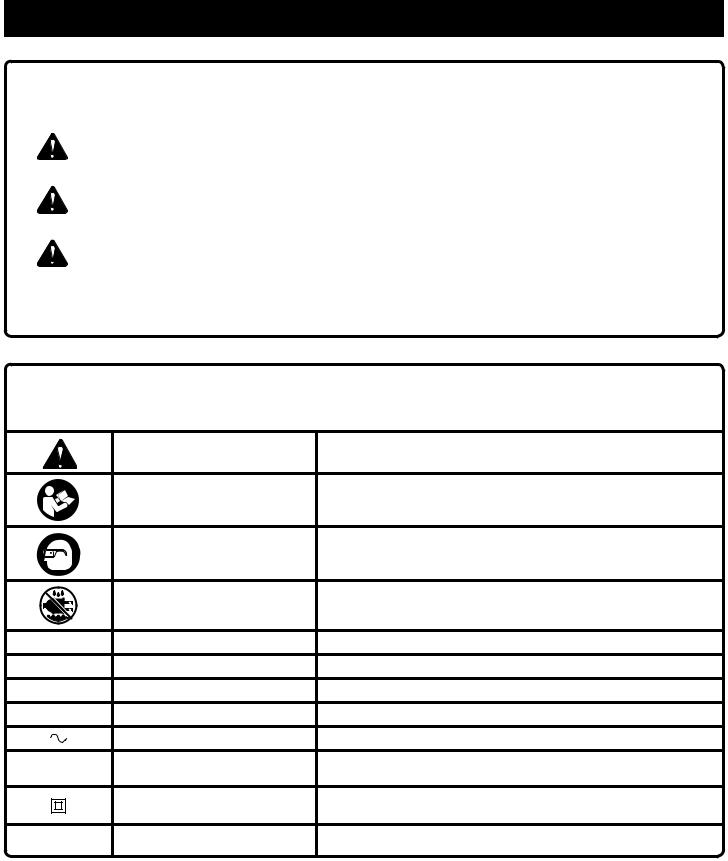
SYMBOLS
The following signal words and meanings are intended to explain the levels of risk associated with this product.
SYMBOL |
SIGNAL |
MEANING |
|
|
|
|
DANGER: |
Indicates an imminently hazardous situation, which, if not avoided, will result |
|
in death or serious injury. |
|
|
|
|
|
|
|
|
WARNING: |
Indicates a potentially hazardous situation, which, if not avoided, could result |
|
in death or serious injury. |
|
|
|
|
|
|
|
|
CAUTION: |
Indicates a potentially hazardous situation, which, if not avoided, may result in |
|
minor or moderate injury. |
|
|
|
|
|
|
|
|
NOTICE: |
(Without Safety Alert Symbol) Indicates important information not related to an |
|
injury hazard, such as a situation that may result in property damage. |
|
|
|
Some of the following symbols may be used on this product. Please study them and learn their meaning. Proper interpretation of these symbols will allow you to operate the product better and safer.
SYMBOL |
NAME |
DESIGNATION/EXPLANATION |
|
Safety Alert |
Indicates a potential personal injury hazard. |
|
Read Operator’s Manual |
To reduce the risk of injury, user must read and understand |
|
operator’s manual before using this product. |
|
|
|
|
|
Eye Protection |
Always wear eye protection with side shields marked to comply |
|
with ANSI Z87.1. |
|
|
|
|
|
Wet Conditions Alert |
Do not expose to rain or use in damp locations. |
V |
Volts |
Voltage |
A |
Amperes |
Current |
Hz |
Hertz |
Frequency (cycles per second) |
min |
Minutes |
Time |
|
Alternating Current |
Type of current |
no |
No Load Speed |
Rotational speed, at no load |
|
Class II Construction |
Double-insulated construction |
.../min |
Per Minute |
Revolutions, strokes, surface speed, orbits etc., per minute |
4 − English
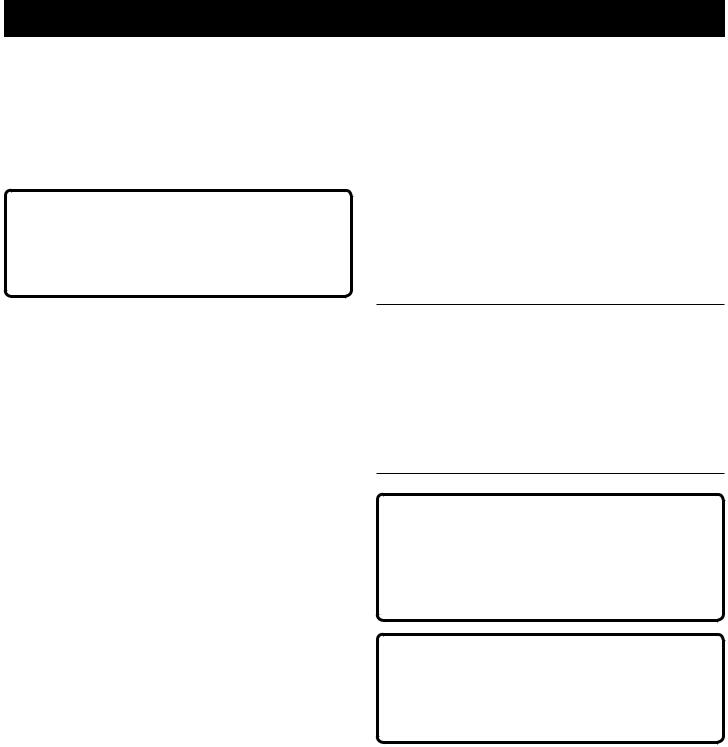
ELECTRICAL
DOUBLE INSULATION
Double insulation is a concept in safety in electric power tools, which eliminates the need for the usual threewire grounded power cord. All exposed metal parts are isolated from the internal metal motor components with protecting insulation. Double insulated tools do not need to be grounded.
 WARNING:
WARNING:
The double insulated system is intended to protect the user from shock resulting from a break in the product’s internal insulation. Observe all normal safety precautions to avoid electrical shock.
NOTE: Servicing of a product with double insulation requires extreme care and knowledge of the system and should be performed only by a qualified service technician. For service, we suggest you return the product to your nearest authorized service center for repair. Always use original factory replacement parts when servicing.
ELECTRICAL CONNECTION
This product has a precision-built electric motor. It should be connected to a power supply that is 120 volts, AC only (normal household current), 60 Hz. Do not operate this product on direct current (DC). A substantial voltage drop will cause a loss of power and the motor will overheat. If the product does not operate when plugged into an outlet, double-check the power supply.
EXTENSION CORDS
When using a power tool at a considerable distance from a power source, be sure to use an extension cord that has the capacity to handle the current the tool will draw. An undersized cord will cause a drop in line voltage, resulting in overheating and loss of power. Use the chart to determine the minimum wire size required in an extension cord. Only round jacketed cords listed by Underwriter’s Laboratories (UL) should be used.
When working outdoors with a product, use an extension cord that is designed for outside use. This type of cord is designated with “W-A” or “W” on the cord’s jacket.
Before using any extension cord, inspect it for loose or exposed wires and cut or worn insulation.
**Ampere rating (on product data plate) |
|
|
|
|||
|
0-2.0 |
2.1-3.4 3.5-5.0 |
5.1-7.0 |
7.1-12.0 |
12.1-16.0 |
|
Cord Length |
|
Wire Size (A.W.G.) |
|
|
||
|
|
|
|
|
|
|
25' |
16 |
16 |
16 |
16 |
14 |
14 |
|
|
|
|
|
|
|
50' |
16 |
16 |
16 |
14 |
14 |
12 |
|
|
|
|
|
|
|
100' |
16 |
16 |
14 |
12 |
10 |
— |
|
|
|
|
|
|
|
**Used on 12 gauge - 20 amp circuit. NOTE: AWG = American Wire Gauge
 WARNING:
WARNING:
Keep the extension cord clear of the working area. Position the cord so that it will not get caught on lumber, tools, or other obstructions while you are working with a power tool. Failure to do so can result in serious personal injury.
 WARNING:
WARNING:
Check extension cords before each use. If damaged replace immediately. Never use product with a damaged cord since touching the damaged area could cause electrical shock resulting in serious injury.
5 − English
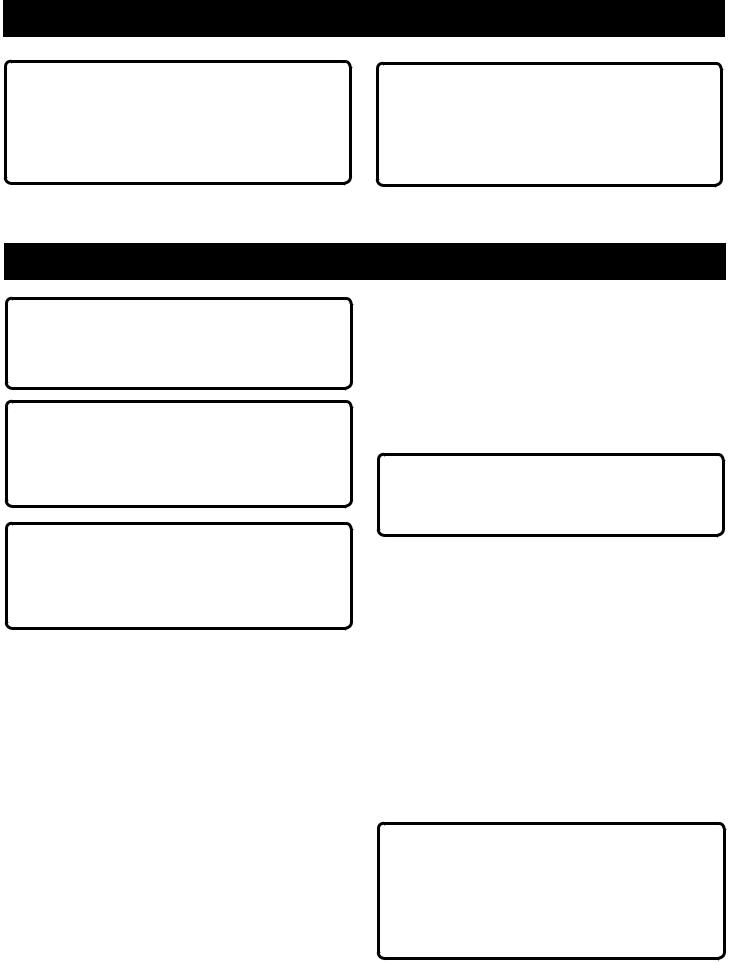
ASSEMBLY
 WARNING:
WARNING:
Do not use this product if it is not completely assembled or if any parts appear to be missing or damaged. Use of a product that is not properly and completely assembled or with damaged or missing parts could result in serious personal injury.
 WARNING:
WARNING:
Do not attempt to modify this product or create accessories or attachments not recommended for use with this product. Any such alteration or modification is misuse and could result in a hazardous condition leading to possible serious personal injury.
If any parts are damaged or missing, please call 1-800-525-2579 for assistance.
OPERATION
 WARNING:
WARNING:
Do not allow familiarity with this product to make you careless. Remember that a careless fraction of a second is sufficient to inflict serious injury.
 WARNING:
WARNING:
Always wear eye protection with side shields marked to comply with ANSI Z87.1. Failure to do so could result in objects being thrown into your eyes, resulting in possible serious injury.
DIRECTION OF ROTATION SELECTOR
(FORWARD/REVERSE)
See Figure 1, page 10.
The direction of bit rotation is reversible and is controlled by a selector located above the switch trigger. With the drill held in normal operating position, the direction of rotation selector should be positioned to the left of the switch trigger for drilling. The drilling direction is reversed when the selector is to the right of the switch trigger.
NOTICE:
To prevent gear damage, always allow the chuck to come to a complete stop before changing the direction of rotation.
 WARNING:
WARNING:
Do not use any attachments or accessories not recommended by the manufacturer of this product. The use of attachments or accessories not recommended can result in serious personal injury.
APPLICATIONS
You may use this product for the purposes listed below:
Drilling in all types of wood products (lumber, plywood, paneling, composition board, and hardwood)
Drilling in ceramics, plastics, fiberglass, and laminates
Drilling in metals
SWITCH TRIGGER
See Figure 1, page 10.
To turn the drill ON, depress the switch trigger. To turn it OFF, release the switch trigger.
VARIABLE SPEED
The variable speed switch delivers higher speed and torque with increased trigger pressure and lower speed with decreased trigger pressure.
NOTE: You might hear a whistling or ringing noise from the switch during use. Do not be concerned; this is a normal part of the switch function.
To stop the drill, release the switch trigger and allow the chuck to come to a complete stop.
NOTE: The drill will not run unless the direction of rotation selector is pushed fully to the left or right.
Avoid running the drill at low speeds for extended periods of time. Running at low speeds under constant usage may cause the drill to become overheated. If this occurs, cool the drill by running it without a load and at full speed.
KEYLESS CHUCK
See Figure 2, page 10.
The drill has a keyless chuck that makes it simple to tighten or release drill bits in the chuck jaws. Grasp and hold the collar of the chuck with one hand. Rotate the chuck body with your other hand. The arrows on the chuck indicate which direction to rotate the chuck body in order to LOCK (tighten) or UNLOCK (release) the drill bit.
 WARNING:
WARNING:
Do not hold the chuck body with one hand and use the power of the drill to tighten the chuck jaws on the drill bit. The chuck body could slip in your hand, or your hand could slip and come in contact with the rotating drill bit. This could cause an accident resulting in serious personal injury.
6 − English
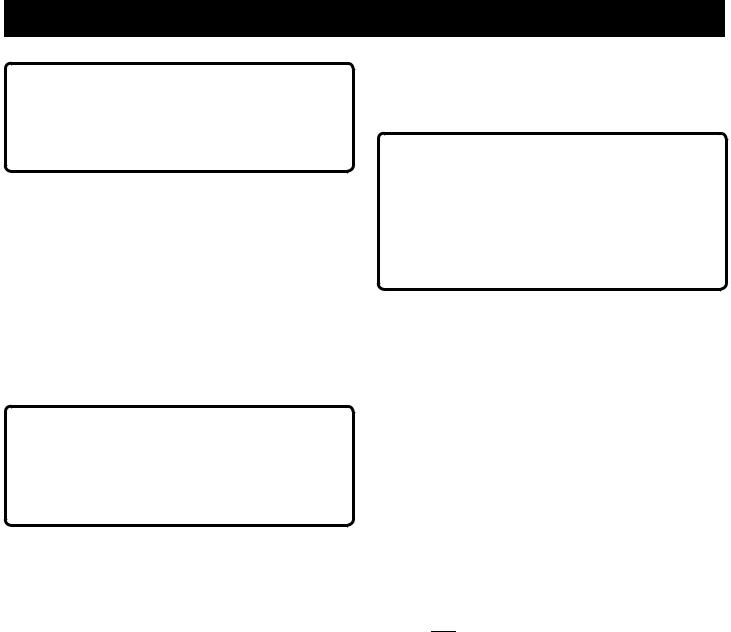
OPERATION
 WARNING:
WARNING:
Always unplug the tool when installing or removing bits, adjusting settings, or when the tool is not in use. Failure to unplug the tool may result in accidental starting and serious personal injury.
BIT STORAGE
See Figure 3, page 10.
When not in use, bits provided with the drill can be placed in the storage area located on the handle of the drill.
INSTALLING BITS
See Figure 4 - 5, page 10.
Unplug the drill.
Open or close the chuck jaws to a point where the opening is slightly larger than the bit size you intend to use. Also, raise the front of the drill slightly to keep the bit from falling out of the chuck jaws.
Insert the drill bit.
To release the lock, depress and release the switch trigger.
If the lock-on feature is engaged during use and the drill becomes disconnected from the power supply, disengage the lock-on feature immediately.
 WARNING:
WARNING:
Before connecting the drill to a power supply source, always check to be sure it is not in lock-on position (depress and release the switch trigger). Failure to ensure that it is not locked-on could result in accidental starting of the drill resulting in possible serious injury. Do not lock the switch trigger in applications where the drill may need to be suddenly stopped.
ADJUSTABLE TORQUE CLUTCH
See Figure 7, page 11.
This product is equipped with an adjustable torque clutch for driving different types of screws into different materials. The proper setting depends on the type of material and the size of screw you are using.
 WARNING:
WARNING:
Make sure to insert the drill bit straight into the chuck jaws. Do not insert the drill bit into the chuck jaws at an angle then tighten, as shown in figure 5. This could cause the drill bit to be thrown from the drill, resulting in possible serious personal injury or damage to the chuck.
Tighten the chuck jaws securely on the bit.
NOTE: Rotate the chuck body in the direction of the arrow marked LOCK to close the chuck jaws. Do not use a wrench to tighten or loosen the chuck jaws.
REMOVING BITS
See Figure 4, page 10.
Unplug the drill.
Open the chuck jaws.
NOTE: Rotate the chuck body in the direction of the arrow marked UNLOCK to open the chuck jaws. Do not use a wrench to tighten or loosen the chuck jaws.
Remove the drill bit.
LOCK-ON BUTTON
See Figure 6, page 10.
This drill is equipped with a lock-on feature, which is convenient for continuous drilling for extended periods of time. To lock-on:
Depress the switch trigger.
Push in and hold the lock-on button, located on the side of the handle.
Release the switch trigger.
Release the lock-on button and the drill will continue running.
ADJUSTING TORQUE
See Figure 7, page 11.
There are twenty-four torque indicator settings located on the front of the drill.
Rotate the adjusting ring to the desired setting.
•1 - 4 For driving small screws
•5 - 8 For driving screws into soft material
•9 - 12 For driving screws into soft and hard
materials
•13 - 16 For driving screws into hard wood
•17 - 23 For driving large screws
•
 For heavy drilling
For heavy drilling
DRILLING
See Figure 8, page 11.
A level is located on the top of the motor housing to help keep the drill bit level during use.
Depress and release the switch trigger to be sure the drill is in the OFF position before connecting it to a power supply.
Check the direction of rotation selector for the correct setting (forward or reverse).
Secure the material to be drilled in a vise or with clamps to keep it from turning as the drill bit rotates.
Plug the drill into power supply. Hold the drill firmly and place the bit at the point to be drilled.
Depress the switch trigger to start the drill.
Move the drill bit into the workpiece, applying only enough pressure to keep the bit cutting. Do not force the drill or apply side pressure to elongate a hole. Let the tool do the work.
7 − English
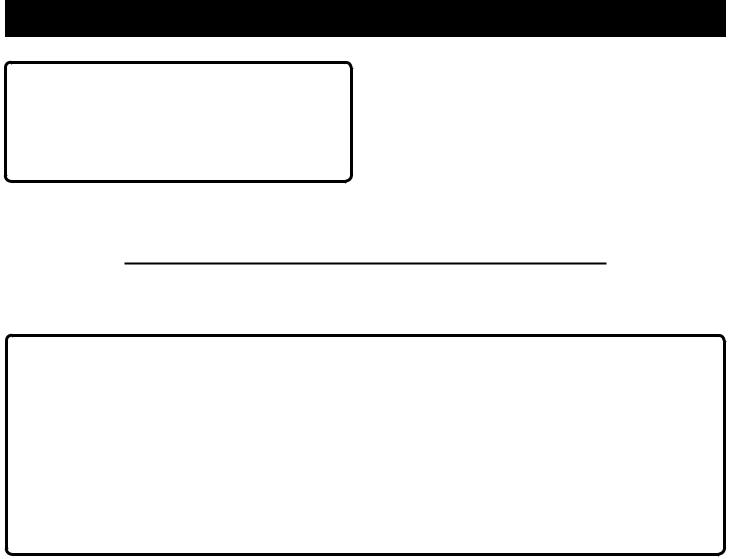
OPERATION
 WARNING:
WARNING:
Be prepared for binding at bit breakthrough. When these situations occur, the drill has a tendency to grab and kick in the opposite direction and could cause loss of control when breaking through material. If not prepared, this loss of control can result in possible serious injury.
When drilling hard, smooth surfaces, use a center punch to mark the desired hole location. This will prevent the drill bit from slipping off-center as the hole is started.
When drilling metals, use a light oil on the drill bit to keep it from overheating. The oil will prolong the life of the bit and increase the drilling action.
If the bit jams in the workpiece or if the drill stalls, stop the tool immediately. Remove the bit from the workpiece and determine the reason for jamming.
CALIFORNIA PROPOSITION 65
 WARNING:
WARNING:
This product and some dust created by power sanding, sawing, grinding, drilling, and other construction activities may contain chemicals, including lead, known to the State of California to cause cancer, birth defects, or other reproductive harm. Wash hands after handling.
Some examples of these chemicals are:
•lead from lead-based paints,
•crystalline silica from bricks and cement and other masonry products and,
•arsenic and chromium from chemically treated lumber.
Your risk from exposure to these chemicals varies, depending on how often you do this type of work. To reduce your exposure, work in a well-ventilated area and with approved safety equipment, such as dust masks that are specially designed to filter out microscopic particles.
8 − English
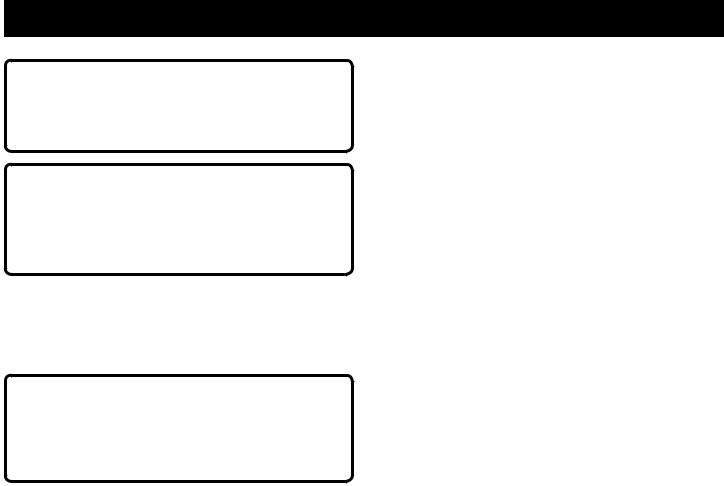
MAINTENANCE
 WARNING:
WARNING:
When servicing, use only identical replacement parts. Use of any other parts may create a hazard or cause product damage.
 WARNING:
WARNING:
Always wear eye protection with side shields marked to comply with ANSI Z87.1. Failure to do so could result in objects being thrown into your eyes, resulting in possible serious injury.
GENERAL MAINTENANCE
Avoid using solvents when cleaning plastic parts. Most plastics are susceptible to damage from various types of commercial solvents and may be damaged by their use. Use clean cloths to remove dirt, dust, oil, grease, etc.
 WARNING:
WARNING:
Do not at any time let brake fluids, gasoline, petroleumbased products, penetrating oils, etc., come in contact with plastic parts. Chemicals can damage, weaken or destroy plastic which may result in serious personal injury.
Electrictoolsusedonfiberglassmaterial,wallboard,spackling compounds, or plaster are subject to accelerated wear and possible premature failure because the fiberglass chips and grindings are highly abrasive to bearings, brushes, commutators, etc. Consequently, we do not recommended using this product for extended work on these types of materials. However, if you do work with any of these materials, it is extremely important to clean the product using compressed air.
POWER SUPPLY CORD REPLACEMENT
If replacement of the power supply cord is necessary, this must be done by an authorized service center in order to avoid a safety hazard.
CHUCK REMOVAL
See Figures 9 - 11, page 11.
The chuck may be removed and replaced with a new one.
Unplug the drill.
Insert a 5/16 in. or larger hex key into the chuck of the drill and tighten the chuck jaws securely.
Tap the hex key sharply with a mallet in a clockwise direction. This will loosen the screw in the chuck for easy removal.
Open the chuck jaws and remove the hex key. Using a screwdriver, remove the chuck screw by turning it in a clockwise direction.
NOTE: The chuck screw has left hand threads.
Insert the hex key into the chuck and tighten the chuck jaws securely. Tap sharply with a mallet in a counterclockwise direction. This will loosen the chuck on the spindle. It can now be unscrewed by hand.
TO RETIGHTEN A LOOSE CHUCK
The chuck may become loose on the spindle and develop a wobble. Also, the chuck screw may become loose, causing the chuck jaws to bind and prevent them from closing. To tighten:
Unplug the drill.
Open the chuck jaws.
Insert a hex key into the chuck and tighten chuck jaws securely. Tap the hex key sharply with a mallet in a clockwise direction. This will tighten the chuck on the spindle.
LUBRICATION
All of the bearings in this product are lubricated with a sufficient amount of high grade lubricant for the life of the unit under normal operating conditions. Therefore, no further lubrication is required.
Open the chuck jaws and remove the hex key.
Tighten the chuck screw by turning counterclockwise.
NOTE: FIGURES (ILLUSTRATIONS) START ON PAGE 10 AFTER FRENCH AND SPANISH LANGUAGE SECTIONS.
This product has a Three-year Limited Warranty.
For Warranty details go to www.ryobitools.com
9 − English
